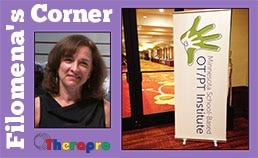
Therapro was delighted to receive an invitation to exhibit at the 2nd Annual School-Based OT/PT Institute in Minneapolis. Registrations for the conference more than doubled from the conference’s inaugural year in 2016, with over 400 attendees! Mary Kay Eastman, PT, MS and her efficient team, including Tanya Grabinski, PT, DPT, MHS, PCS, Margaret Knebel, MEd, OTR/L, and Michelle Schlueder, PT, DPT ran a well-planned and well-orchestrated conference that won rave reviews all around.
The Keynote speaker, Kathy Flaminio, MSW, opened the conference with “Taking Care of Yourself Inside and Out: Nourishing Your Mind, Body and Heart.” Speakers presented on a variety of timely topics including “Meeting Sensory Needs in the General Education Classroom,” “Effects of Mobility on Cognition,” “Emerging Evidence in Pediatric Brain Injury: Role of School-based Services.”
Attendees visited the Therapro exhibit with many positive comments that warmed our hearts. Therapists told us “I love Therapro – my favorite place to get therapy supplies!” and “It’s good to have a conference where vendors are zeroed in on what we need!” We enjoyed helping the therapist who is working at a brand new Charter school with no therapy materials. We helped her select “must have” items such as Pencil and Hand Gripper Sampler 1, Raised Line Paper Assortment, Fine Motor Olympics, Fidget Kit, and Drive Thru Menus, and much more!! Therapists told us they were excited to try out our products and examine books they had only seen in the catalog.
We love getting feedback on Therapro products that therapists use and love. We heard that Learn to Dress Monkey is a big hit in a preschool class in which students love to dress and undress the adorable stuffed animal while practicing 11 dressing skills including zipping and buttoning. Frog and Turtle Beanbags were popular with both PTs and OTs who use them in many creative ways. The one that stands out involves launching them from a platform by having a child stomp on a connected spring device. So clever AND fun!
Therapro’s I Can Work! 5-module prevocational curriculum drew much interest for therapists who work with middle school and high school age students. Having the manual available now in printed form along with the CD was a bonus for therapists.
Our experience at this conference was outstanding. We loved the opportunity to share ideas and receive feedback from our colleagues in the Midwest. We hope to see you next year!
Filomena Connor, MS, OTR/L
